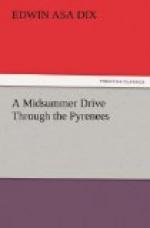III.
There is a little custom-house on the bank, but our impedimenta are safe in Hendaye. I think our passports are there as-well, so bold does one grow upon familiarity.
We have scarcely traversed a hundred yards before we come upon the middle centuries. There will be no caviling at the satisfying antiquity of Fuenterrabia. We have passed in between the lichened walls which still guard the city, and a few steps bring us into the town and to the foot of the main street. We pause to look, and the sight is certainly striking. Beyond a doubt Fuenterrabia is old. It has a true Spanish tint, and one dyed in the wool; one might probably travel far in Spain before meeting a truer. This street seems utterly unmodified by modern formulae. Wavering and narrow and sombre, it stretches upward on a gradual incline until it meets the cathedral stepping out from the line of the old houses and closing the vista. Even in the short perspective, the huge, blackened eaves of the opposite roofs seem almost to meet. Balconies, associated with moonlight and mandolins, serenades and senoritas, jut out from every window; dark bosses of escutcheons mark the fronts; and below, along the edging of sidewalk, are the dim little shops, curtained by yellow canvas, intensely and delightfully local, and wholly unknowing of outside demand or competition. One of these places does indeed cater to visitors with a humble supply of photographs and of clicking sets of varnished wooden castanets paired by colored worsteds; but the others of the store-keepers and the inhabitants in the streets are clearly unhardened to foreigners, and regard us solely with a deep and artless curiosity,—tempered, I hope, by admiration. As the town has been, so it is. It is an epitome of Spain and her past.
IV.
At the head of the street we enter the cool cathedral, and find, as always, wealth created by poverty. In places such as these one realizes the hold of the Romish system on mediaeval Europe. One realizes its power also. No matter what the size of a town, it boasts its costly church; oftener, as here, its cathedral. Villages, houses, people, may be poor, their church stands rich; they may be unlearned in art and in culture, their church stands a model of both. There was their shrine, their finality,—in religion not merely, but in art and wisdom and authority.
At least, the Catholic system held its followers firmly in leash. Condemn its errors and excesses, yet, these apart, it was marvelously adapted to its mission. As an engine of unification it was almost omnipotent. Through the ups and downs of restless migrations and invasions,—of feudalisms and governments and the soberer commercial spirit,—it has kept its hold unbroken upon the mass of European humanity. Its priests and popes might sink out of respect; the Church did not sink. In the fiercest civil feuds, its abbeys were held inviolate. To the most brutal, the Church had an odor of sanctity. Its threats terrified; its mandates were obeyed; it was the one persistent, binding principle; it held men in check from a relapse into tribalism.




